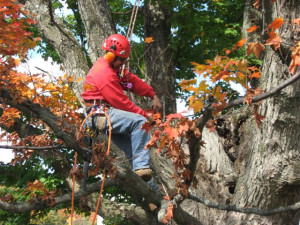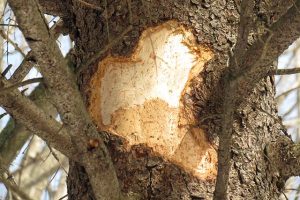In many parts of Vermont, people will soon enjoy one of nature’s finest shows – fall foliage. Color-changing leaves make for a beautiful display, but early changes in leaf-color can be a sign that your tree is stressed and vulnerable to insect and disease attack.
Not all trees and regions change color at the same time, but if the leaves on a specific tree are changing color and falling long before others around it, there could be an issue. We’ll be able to inspect for potential damage, insect infestation, diseases, or other warning signs.
Why it Matters

“Premature color change can be an indication that a tree isn’t vigorous enough to withstand insects and disease organisms that may attack it, not to mention the usual changes that occur when the weather turns cold,” says Tchukki Andersen, BCMA, CTSP* and staff arborist with the Tree Care Industry Association. “Occasionally, only one or two limbs of the tree will show premature fall color. This could be a sign of a disease at work, though only the infected limbs are weakened.”
The more common situation is for the entire tree to exhibit premature fall coloration, a phenomenon usually linked to root-related stress. “Trees respond to these stresses by trying to curtail their above-ground growth,” adds Andersen.
Leaves Know Best

Leaves can be thought of as small factories containing raw materials, products and by-products, all in chemical form and some with color. As the leaf is “abandoned” by the tree, the green chlorophyll – the dominant chemical found in most leaves – is broken down and “recycled,” leaving behind other-colored chemicals. Supply lines to the leaves also become clogged, affecting which chemicals are left in the leaf: If the major chemical remaining in the abandoned leaf is red, the leaf turns red; if it’s yellow, the leaf turns yellow, and so on.
“The yearly variation in color intensity is due to fluctuating weather conditions, which can affect the balance of chemicals and their composition in the leaves,” Andersen says. Differing amounts of rainfall, sunlight, temperature, humidity and other factors may have an effect on how bright and how long the “leaf-peeping” season will be in any given year.
What to do

Take a look at the entire tree. See if there are visible signs of damage to the roots, trunk and/or branches. Just because colors are coming early, that doesn’t mean your tree is doomed or it needs to be removed.
As professional arborists, we can assess your tree and landscape and work with you to determine the best course of action, if necessary. We may also recommend treatments, including planting new trees, correcting soil deficiencies, increasing water and nutrients, monitoring for pests or providing pest management.
Give Us a Call

As with anything dealing with the trees on your property, never hesitate to give us a call. It’s easy to view trees as long-lasting, strong, indestructible plants and while in many cases that’s true, they are also vulnerable to a variety of changing conditions. It’s important to monitor trees, limbs, and leaves to be sure your property is always healthy, safe, and beautiful.



